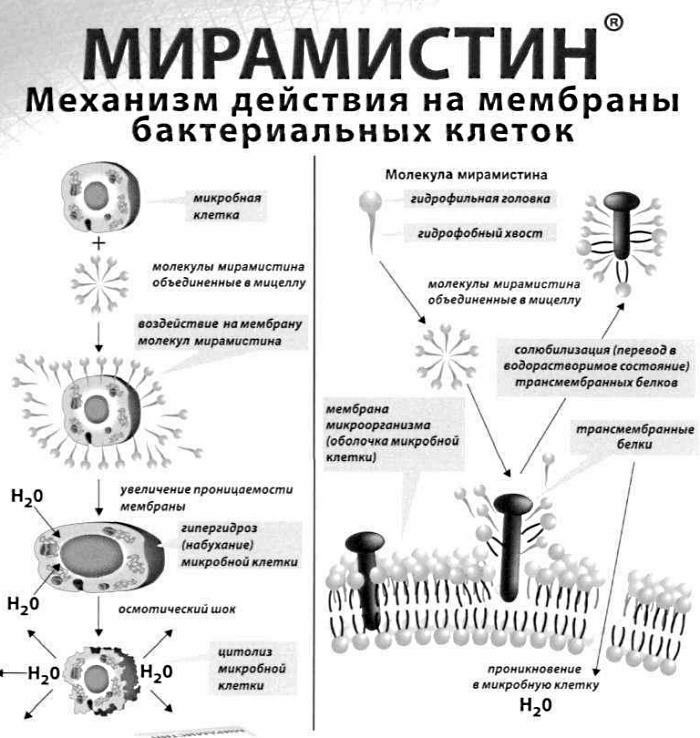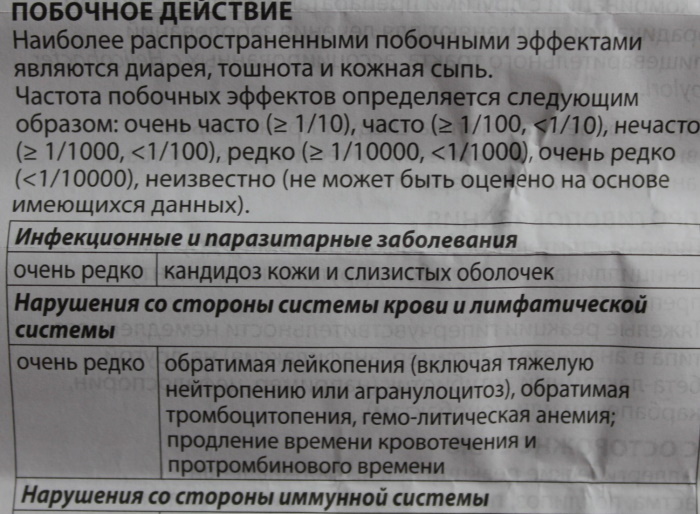Content
- What is the follicular phase?
- Features and duration of the follicular phase
- Early follicular phase
- Middle follicular phase
- Late follicular phase
- On what day does the cycle start and how many days does it last?
- Calculation of the duration of the follicular phase
- Signs of the follicular phase of the cycle
- Basal temperature
- The rate of hormones in the follicular phase
- Follicle stimulating hormone
- Luteinizing hormone
- Estradiol
- Progesterone
- Prolactin
- Phase failures
- How does follicular phase failure manifest?
- Is it possible to get pregnant during the follicular phase?
- Follicular phase video
In medicine, the follicular phase is the primary stage in preparing a woman's body for ovulation. This is an integral part of the next two phases. menstrual cycle, during which the egg is formed, fertilized and fixed in the uterus.
During the follicular phase, the dominant follicles and germ cells grow. At the same time, the necessary environment is formed in the uterus for the adoption of a fertilized egg.
What is the follicular phase?
When a woman reaches reproductive age, every month her body begins to prepare to receive a fertilized egg. The follicular phase is one of the stages of this process.
| Phase of the menstrual cycle | What changes are taking place | How many days does it last |
| Follicular | Comes with the first day of menstruation. This period falls on the active rejection of the endometrium. Also, with FF, the dominant follicle is determined. | 7-22 |
| Ovulatory | Begins on the 7th day of menstruation. Active growth of the dominant follicle begins. It also begins to produce the female sex hormone estradiol. On the last day of the ovulatory phase, the follicle ruptures, the egg is released. | 2-3 |
| Luteal | It starts right after ovulation is over and ends when a woman starts a new period. During this period, the so-called corpus luteum develops, progesterone is produced. | 10-14 |
The follicular phase is one of the stages of the menstrual cycle. Since it differs in women in duration, the exact time for the development of the dominant follicle is determined in private.
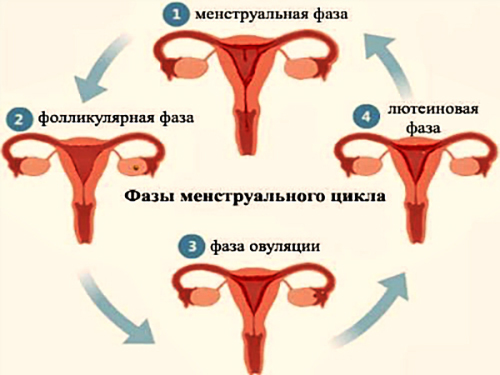
According to medical statistics, the longest menstrual cycle is recorded in women between the ages of 25 and 30. After that, the intensity of secretions and other signs of preparation of the body for fertilization decreases. By age 40, your menstrual cycle becomes even shorter. All these changes are just due to the duration of the follicular phase.
Features and duration of the follicular phase
This phase of the menstrual cycle is also divided into several stages, which are worth considering in more detail.
Early follicular phase
This phase is the period in which the ovary is characterized by minimal hormonal activity. This is the reason for the lower content of estradiol, as well as progesterone. As soon as the feedback of hormones decreases, early FF begins.
The frequency of oscillations of gonadotropin increases. This triggers the increase in FSH. At the same time, the indicators of its content increase by 30%.
Also, the early stage is characterized by the fact that during this period the concentration of inhibitor B reaches its maximum values. This plays a role in suppressing the subsequent growth of FSH. Simultaneously with this, there is a rapid increase in fluctuations in the concentration of LH.
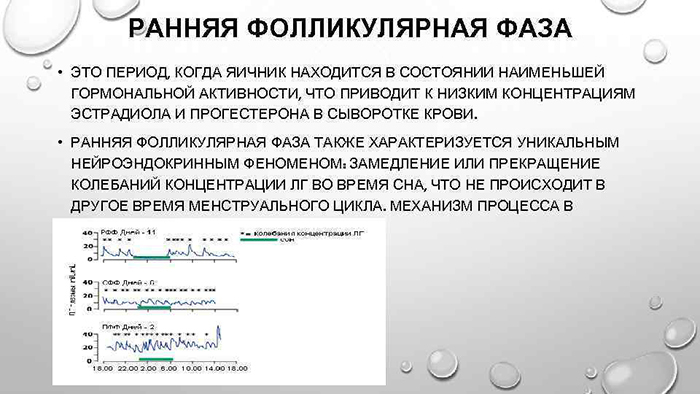
Additionally, a unique phenomenon can be distinguished, which is recorded with the onset of this phase. During sleep, LH fluctuations are greatly slowed down or stopped altogether. In other phases of the cycle, this does not happen. This unusual mechanism has not yet been described and is only being studied.
Middle follicular phase
With the advent of this phase, a sequential increase in FSH secretion begins. This stimulates the process of folliculogenesis and activates the active production of estradiol. Against this background, the growth of follicles begins. Several of them mature and pass into the antral stage. At the same time, the amount of estradiol and inhibin A increases.
Since estradiol begins to produce in a negative feedback loop, this affects the pituitary gland and hypothalamus. The amount of FSH and LH in the blood serum is reduced. The amplitude of LH oscillations also slows down.
GnRH is also stimulated during this phase. This is because the negative feedback effect becomes less noticeable. Additionally, changes in the endometrium and ovaries of a woman are recorded. If you perform an ultrasound scan in the first week of menstruation, then when examining the ovaries, antral follicles are clearly visible, the size of which is 9-10 mm.
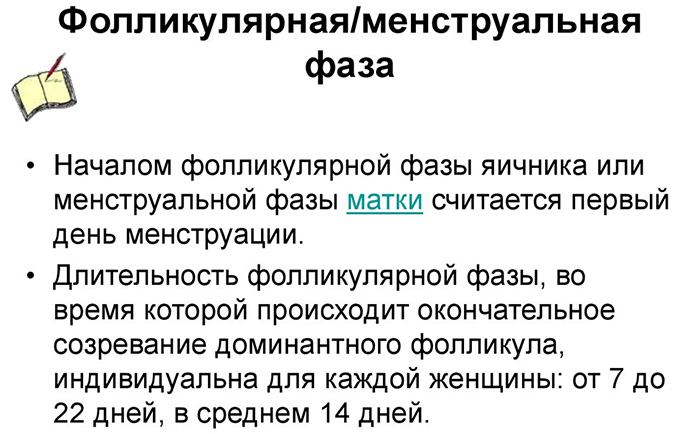
Since during this period the concentration of estradiol increases, endometrial proliferation begins. It thickens and an increase in the number of glands occurs.
Late follicular phase
With the arrival of late FF, an increase in the concentration of inhibin A, as well as estradiol, is recorded. This happens every day for 7 days until ovulation occurs. This activity is due to the fact that the growing follicle begins to secrete these hormones.
Simultaneously with this, FSH and LH begin to fall. This is due to a negative (reverse type) relationship between estradiol and other hormones that are produced by the ovaries. After the dominant follicle of FSH is secreted, LH receptors begin to appear. Against this background, there is an increase in intrauterine growth factors.
During the late phase, changes occur not only in the ovaries, but in the endometrium, as well as the mucous membrane of the cervical canal. In this case, one dominant follicle has already been identified, and the remaining maturing follicles stop developing and undergo atresia.
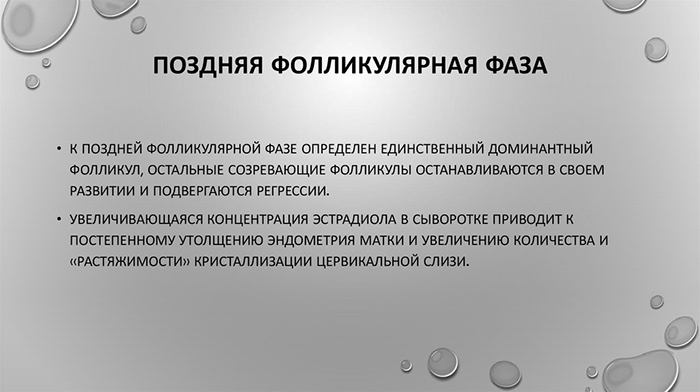
The main follicle, on the contrary, begins to actively increase (2 mm per day). It reaches its mature state with a diameter of 20-26 mm.
Against the background of an increase in estradiol, thickening of the endometrium of the uterus begins, cervical mucus becomes more elastic. At the same time, such changes are noted by women themselves, who note changes in the structure of mucus.
Studies of this material have shown that the highest concentration of MUC5B protein is observed in the late follicular phase. It is necessary for better sperm penetration.
On what day does the cycle start and how many days does it last?
The follicular phase is the beginning of the menstrual cycle. Accordingly, it begins from his first day. This period is characterized by the first spotting.
The length of the phase depends on the cycle. If it is standard and lasts 28 days, then the transition to the next stage begins in 14-15 days. However, the maturation of the egg may vary. Therefore, it is usually noted that the duration of the follicular phase can be from 7 to 22 days.
Calculation of the duration of the follicular phase
The pituitary gland is responsible for the growth of follicles and the subsequent formation of the egg. It controls the production of FSH and LH.
The duration of the phase is of two types:
- short - 7 days;
- long - 22 days.
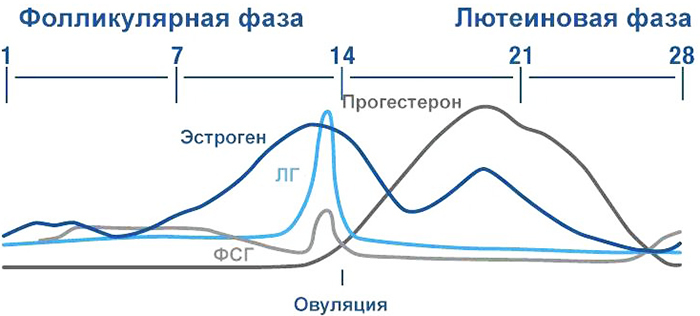
To calculate the duration, you need to correctly determine the day of ovulation. For this, women use special testers or measure basal temperature (through the rectum). When the follicular phase is over, the basal rates begin to change dramatically. This indicates a transition to the luteal phase, when other hormones begin to be produced in a larger volume.
Accordingly, the follicular phase lasts from the first day of the onset of menstruation until the onset of ovulation. However, this is not a constant value, so each calculation is individual.
Signs of the follicular phase of the cycle
The follicular phase has several characteristic features.
This allows us to determine its approximation:
- pain in the area of the mammary glands and their increase;
- an increase in the volume of mucous secretions;
- change in the structure of secretions.
Basal temperature
The follicular phase can also be determined by changes in basal temperature.
| Cycle phase | Which hormone prevails | Features of basal temperature |
| Follicular | Estrogen | Temperature readings are kept low |
| Ovulation | Estrogen decreases and progesterone increases | Temperature increased by 0.4 degrees |
| Luteal | Progesterone | Temperature readings increase and stay at the same level. |
It should also be taken into account that basal temperature can be influenced by:
- stress;
- sleep problems (lack of sleep);
- a sharp change in the daily routine;
- having sex life;
- chronic, acute and other diseases (for example, with ARVI, even if the infection is not accompanied by a high body temperature);
- alcohol consumption;
- change of time zone or acclimatization;
- diarrhea, constipation and other gastrointestinal problems;
- taking medications.
Under these circumstances, accurate data cannot be obtained. Therefore, measurements must be continued over several cycles, recording all changes in basal temperature in a special diary.

It is better to take measurements immediately after sleep. Therefore, even in the evening, you need to put a thermometer next to the bed. If you get out of bed and only then measure your basal temperature, then the data will most likely be inaccurate.
It is also worth clarifying that such a temperature measurement is performed only in the anus. It is not worth determining the indicators in the mouth or vagina, since they cannot be 100% correct.
The rate of hormones in the follicular phase
The pituitary gland and hypothalamus are parts of the brain that are responsible for reproductive function in a woman's body and provide:
- production of hormones;
- follicular growth;
- ovarian activity;
- the onset of ovulation;
- preservation of a fertilized egg.
As soon as menstruation begins, the hormonal balance changes in the blood. If you pass the appropriate tests 3-5 days from the beginning of your period, you can get information about the level of hormones.
If, when receiving the results, the doctor notes a strong deviation from the norm, then he prescribes a re-delivery of tests at the beginning of the next cycle. There are several hormones that are especially important during the follicular phase.
Follicle stimulating hormone
The follicular phase is actually a change in FSH levels that stimulates follicular development. Also, this hormone takes part in the formation and preparation for fertilization. To get information about FSH, it is necessary to pass an analysis on the 5th day of the appearance of spotting.
The FSH rate is as follows:
- during the follicular phase - 1.1-11.5 U / ml;
- with ovulation - 4.9-21 U / ml;
- at the last phase of the cycle - 1.1-9.5 U / ml.
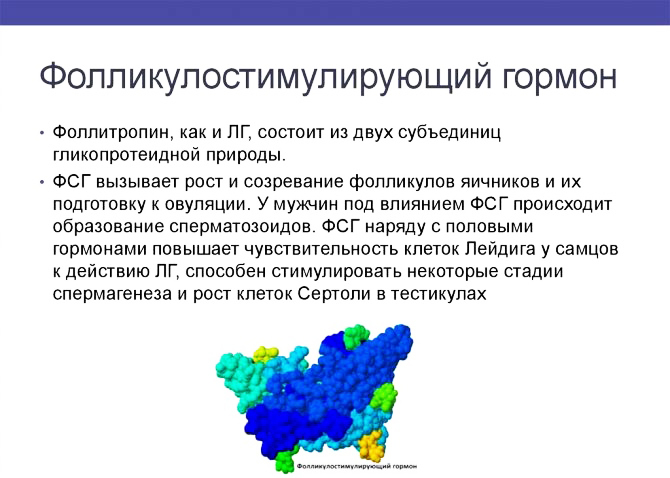
If these values are lower or higher, then this may be due to the onset of tumor processes in the gonads. This also happens when the pituitary gland does not work properly or if the woman is pregnant.
Also, the level of the hormone may differ depending on the age of the patient. For example, at the age of 11 years, follicle-stimulating hormone should not be more than 2 U / ml. For women who are already ready to bear a child, this value is 2-3 times higher.
Luteinizing hormone
As a rule, the level of LH is determined simultaneously with FSH. It is considered normal when at the initial stage of the follicular phase this indicator is insignificant, but at the end of the initial stage of menstruation it rises sharply. This is the main sign that the egg can be fertilized successfully.
LH standards are as follows:
- at the initial stage of menstruation - 2-15 U / ml;
- with the onset of ovulation - 24-140 U / ml;
- to the last phase - 2-14.4 U / ml.
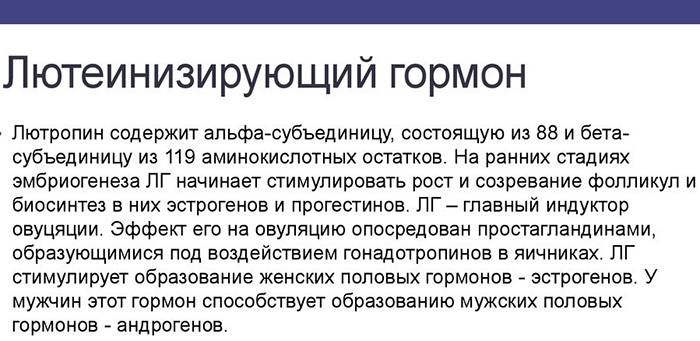
In patients whose age is less than 11 years, this indicator does not exceed 14 U / ml and is kept at a lower level even during ovulation.
If there is a deviation in the values, then this indicates the presence of neoplasms on the ovaries. This also happens when the pituitary gland fails. If LH values are quite high, and FSH, on the contrary, is lowered, then a sufficient number of eggs have not formed in the ovaries, which could begin the normal ovulation process.
Estradiol
The ovaries and adrenal glands produce enough of this hormone to start the growth of the endometrium and the development of follicles. The inner layer of the uterus also undergoes monthly changes. With the onset of polyiferation, the endometrial tissue grows, thickens and dies off.
The endometrium goes through several stages of formation:
- Early. By the 5-7th day of the cycle, stand becomes thin. It also has a pale pink tint.
- Average. Starts on day 8-10. During this period, the epithelium becomes thicker and looser.
- Late. By 11-14 days, the endometrium thickens, thick folds appear on it.
When the uterine cavity begins to clear (during menstruation) from the dead endometrium, its new layer immediately begins to form. Due to the influence exerted by estrogen, the epithelium prepares to receive an already fertilized egg.

To investigate the level of estradiol, FF in the initial and middle phase is also determined. If the tests are given after ovulation, then the hormonal substances will be quite low. The normal value of estradiol in the follicular phase is 5-53 pg / ml for women and 5-21 pg / ml for patients under 11 years of age.
If, according to the results of the study, it turns out that the level of the hormone is too low or, conversely, high, then the problem may be in the functionality of various organs. Failure could occur in the ovaries (for example, with the development of polycystic disease), thyroid gland, liver. Inconsistency of indicators is often recorded during pregnancy or if a woman is taking hormonal drugs.
Progesterone
Tests for this sex hormone must be taken in the 2nd part of the cycle, that is, 2-3 days after ovulation. Studies are carried out during the follicular phase. In this case, the blood serum should have the minimum indicators of progesterone, or rather 0.32-2.23 nmol / l.
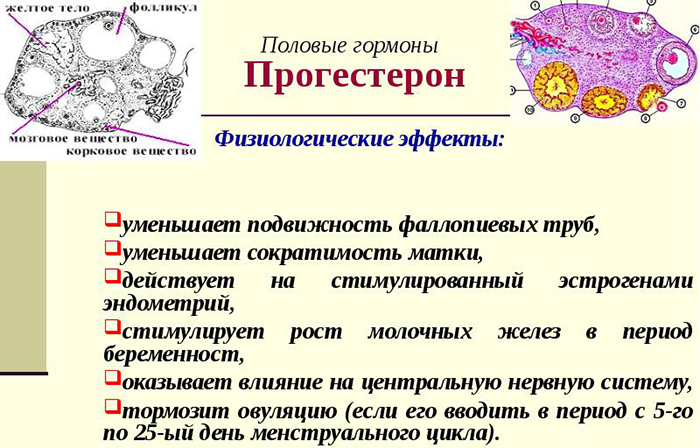
If the hormone contains more than the norm, then this is a sign of the onset of the development of a cystic or tumor process in the ovaries. Also, the reason may be in disruption of the adrenal glands. This often happens if the menstrual bleeding is irregular.
Prolactin
This hormone is also produced by the pituitary gland. Prolactin is essential for stable milk production during lactation. Prolactin levels can be elevated if a woman is engaged in hard physical labor, with frequent sexual intercourse or under stress.
The normal prolactin value for a non-lactating woman is 140 to 550 mU / ml. In case of deviations from the norm, the doctor suspects problems in the work of the pituitary gland or adrenal glands. If the patient is less than 10 years old, then the normal value is 90-250 mIU / L.

Before testing for this hormone, patients are advised to have a good rest, do not eat heavy foods and avoid physical exertion. Determination of the level of the hormone is most accurate on the 3-5th day of menstruation.
Phase failures
The follicular phase is the stage of the cycle that allows you to determine the most successful day for conception. Ovulation is the final stage of this phase. However, it does not always occur. The lack of ovulation indicates a possible hormonal imbalance.
For example, when the pituitary gland begins to secrete insufficient LH. This leads to the fact that the follicle simply cannot rupture. Against this background, fertilization becomes impossible, that is, the egg will not come out into the uterine cavity.
There are several reasons for FF failure:
- physical exercise;
- a long period of using oral contraceptives;
- hormonal problems;
- recent childbirth (a high probability of complications occurs during natural childbirth);
- abortion;
- the presence of tumor formations.
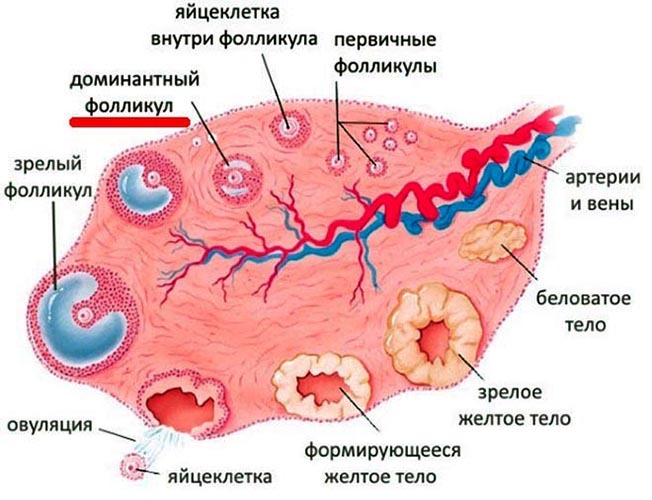
If the follicle is unable to go outside, then it remains in the ovarian cavity. However, the maturation of a new egg is already beginning in it. This can provoke the formation of a cyst. This problem is especially dangerous if the patient has already had polycystic disease in the past. If diagnosed with multiple cysts, it can lead to rupture of the ovary.
Against the background of FF deficiency, which occurs due to too abundant bloody discharge or, conversely, their absence, one of the forms of infertility may develop. This is confirmed by an ultrasound study. In such a situation, the doctor usually decides to adjust the hormonal background in the patient's body through medication.
Less commonly, a decision is made to perform a minimally invasive operation called laparoscopy. This allows you to "activate" the follicular phase, which will begin and end according to the norms.
If a woman complains of constant and long delays in menstruation, then anovulatory cycle is diagnosed.
How does follicular phase failure manifest?
Against the background of hormonal disruption in a woman's body, various kinds of disturbances can occur. The main sign of insufficient or too high hormone production is the lack of ovulation or signs of infertility.
The main manifestations of FF deficiency are:
- constant delays in menstruation (while a woman may not experience any additional inconvenience);
- the presence of bloody discharge between periods;
- the inability to conceive a child even with the correct calculation of FF and ovulation.

In such situations, the doctor prescribes an ultrasound scan. Ultrasound examination allows timely detection of the first signs of polycystic disease, anovulation, as well as multifollicular ovaries. Sometimes for
Is it possible to get pregnant during the follicular phase?
Pregnancy can only occur as a result of the successful fertilization of an egg with a sperm. As a rule, the most favorable moment for this is ovulation. Before her, the probability of pregnancy is minimal.
Nevertheless, in medical practice, there are sometimes cases when a woman ovulates earlier than expected, that is, already on the 7th or 10th day of her period. In such a situation, the follicular phase is much shorter, and pregnancy actually occurs during the ovulatory period.

It should also be borne in mind that sperm cells are distinguished by high vitality in the conditions of the body. They can retain their function for up to 7 days. Accordingly, even if unprotected intercourse took place a week before the actual ovulation, this can lead to pregnancy.
Therefore, situations often arise when it seems that pregnancy occurred before ovulation, although in fact it was just about tenacious sperm.
Thus, the follicular phase allows you to determine the most favorable time for conception (or more "dangerous" days, if pregnancy is not planned yet). This is an integral period of the cycle, if it fails, various serious pathologies can develop. Therefore, if there are signs of a violation of FF, it is worth contacting a gynecologist.
Follicular phase video
Follicle development stages:

